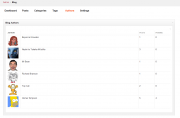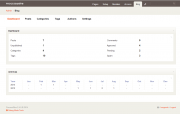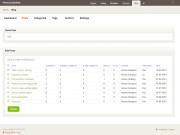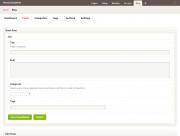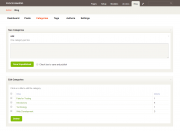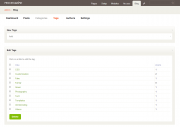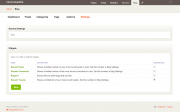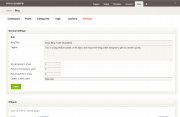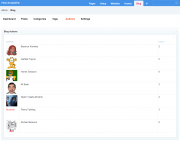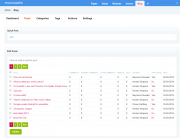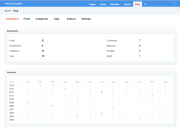-
Posts
7,529 -
Joined
-
Last visited
-
Days Won
160
Everything posted by kongondo
-
fenton, Good question. It's something I've been discussing with some people. Currently, the only way to achieve this is to clone the module and modify it (typically paths and selectors) to read your news section pages (i.e. the fields). Obviously, that is not ideal or for everyone. However, Blog is meant for, er blogging. So, another solution is needed. The current idea is to create a separate (but similar) skeleton module that is highly configurable and adaptable to different needs such a news site, etc. At the moment, this is still an idea. There is no ETA yet Cheers.
-
Thanks for filing this in GitHub. I currently have this working on my local install. Added a 'blog_excerpt' integer field to the 'blog' template. Will also enable editing via the 'Settings' tab in ProcessBlog. Due to the nature of this module, for existing installs (i.e. if you've already installed ProcessBlog) you will have to manually create the field; The module will not attempt to modify existing fields; the risk of corrupting/loosing your data means it's not worth it . I'll post a notice here once I have updated the module, thanks.
-
blog_date field You are right. It should be about the post publish date. I don't think this will be difficult to implement - I'll just steal and modify the code here by SiNNuT and Soma . I'd still like to leave a manual override (i.e. not disable user editing of it); I envisage cases where a post is published 'by mistake' and has to be recalled for later publication. Scheduled Pages I'll have a think about this one. I can see the potential. Thanks for your ideas!
-
@looeee, Thanks for further testing this. One thing I have tried to clarify in my posts further up is that the included Template Files are just demos. Some of the code in there is not even related to MarkupBlog. The code in the Template Files is also deliberately verbose. For instance, there is a lot of repetitive code that could be best split up into includes. I decided to leave it like that so that users could select whatever templating approach they wanted (yes, refactoring needed; I might revisit this decision in future). In order to do this effectively, they need to be familiar with the methods/functions available in MarkupBlog . So, I will be writing up a guide covering those methods (e.g. your examples above). Configurable Excerpt Length: Good suggestion. Please file an issue on GitHub if you can so that I don't forget this. Cheers.
-
In the case of Blog, if any Template File with an identical name is found, it is NOT overwritten (it will be skipped over instead). For all other items (Fields, Templates, Pages, Role) if even one identically named item is found on a site where you are trying to install Blog, then ALL these items will not be installed in order to avoid potential data loss. ProcessBlog 'Dashboard' would still be installed (although it wont be of much use; you would probably need to uninstall it )... See the README. This info is included there (have subsequently made it clearer)... Thanks!
-
Update: And we are off...'Blog' is now available in the modules directory. Updated first post...
-
@looeee, Welcome to the forums! I'm glad the module is of benefit... Currently, there is no comment moderation within Blog itself. This is deliberate. You have two choices: 1. You can install the module 'Comments Manager' to manage all your comments in one place. It would have been nice to integrate Blog and CM better but currently there are no plans to do so. 2. You can moderate comments on a per post basis. Just edit a post and you will find all comments awaiting your approval
-
Welcome Ukyo! Thanks for the contribution!
-

Completely stuck with a templage coding matter - help appreciated
kongondo replied to totoff's topic in API & Templates
Edited above code in my post to make it tighter...+ clarified some stuff... -

Completely stuck with a templage coding matter - help appreciated
kongondo replied to totoff's topic in API & Templates
I see two problems One, on this line, since this is within the foreach, everytime it gets a new record (page) - i.e. on each new loop, you are wiping out the previous value of $out...hence, in your last code, it will only output the last record having wiped out all previous ones. $out = "<div class='referenceTeaser post'>"; The second problem is with your first code; you are returning $out within the foreach. It should be outside the foreach. The idea is that you need to return what you want to finally output/use...So, we don't return anything too early... Try the below code, modified from your second code attempt. We first initialise $out outside the foreach...Subsequently, we concatenate it. In addition, it is not always a good idea to use the same variable name for different things. E.g., you already have $page = wire('page'); In your selector, I would use $children = ...blah blah. function renderReferenceList() { $out = '';//initialise the variable $out //$page = wire('page');//no need for this as well $pages = wire('pages'); //$page = $pages->get(1065); // Referenzen//no need for this here; combined below $children = $pages->get(1065)->children("limit=15, sort=-date");//changed variable name to $children foreach($children as $child) { $out .= "<div class='referenceTeaser post'>";//note the concatenation $out .= "<h3 class='articlehead'>{$child->headline}</h3>"; $out .= "<p>" . $child->summary . "<a href='{$child->url}'><i class='more'>Referenz ansehen</i></a></p>"; $out .= "</div>"; } return $out; } -
If you are bootstrapping PW you cannot use $page...OK, I stop here; Horst was faster! Edit: To avoid magic quotes issues, you also want to use wire('input')->get rather than $_GET. http://processwire.com/api/variables/input/
-
Follow-up to my post above about the 'example template files': 1. If you decide to hide some widgets (say recent posts), the HTML is still showing up and reporting 'no posts found'. That's just an oversight on my part. 'Unavailable' widgets should not even output their HTML; 'no posts found' should mean exactly that. I'll try to fix this later, but it is not a high priority . 2. On a related issue, you will need to install and configure MarkupTwitterFeed in order to use the example 'Twitter Widget'. Update: I have updated the example Template File 'blog-recent-tweets.php'. The references to some fields were wrong . Also updated the README + First Post.
-
Steve, I am wondering if it is useful to also include the CHMOD values (777, etc)? Just thinking out loud... Very, very trivial request: Please change Ok to OK...
-
If you are using ProcessWire 2.4 (which I assume you are), all you probably need to copy over is the folder /wire/ (deleting/replacing the old /wire/ first). ProcessWire never touches your site's folders, i.e. /site/. In some upgrades, replacing the old index.php and .htaccess may be necessary. If this is required, it is specified in the upgrade process. If you only need to copy over /wire/, instead of replacing the old /wire/, you can just rename it to say, /wire-old/. This way, you can quickly test the old (2.4) and the new (2.5)....by renaming the respective folders. Note: only do this if you know what you are doing ....In addition, as much as upgrading PW is relatively safe and easy, always make a back-up of your database...(which you should be doing anyway regardless of upgrades...)
-
Thanks for clarifying. Fixed in the latest commit. I think the problem was that you have a page called widgets. The previous selector was looking for pages with a parent 'widgets'. Good catch! I have changed the selector to be more specific.
-
Update: After closing an edit modal (widgets, posts, tags, categories), the parent page now refreshes to reflect relevant changes (e.g. date, author, published status, etc)...
-
Nice one Steve!!
-
-
Hi all, Thanks for testing and comments. Template Files One thing I should have clarified. The included demo example template files are just that; a demo. They are not part of the 'blog' module. They are not meant to showcase any templating approach. They are intentionally verbose (e.g. similar markup repeated across all of them as opposed to, for example, using head.inc, footer.inc or some other approach e.g., main.php, etc.). The idea is that the user decides how to structure their blog, what CSS framework to use (or not to use), JS, etc. On the contrary, the template files are meant to showcase MarkupBlog. What you can do with its methods/functions. Yes, MarkupBlog generates some markup but these are necessary and minimal. Using wrapper DIVs etc, as shown in the example template files, you can structure your blog however you want to fit in your new/existing site. Even the CSS and JS are demos! . In a nutshell, MarkupBlog does not come with its own CSS and JS. What is included is just meant to give you an idea of how to use it . In due course, I will do a write-up of all the methods available in MarkupBlog and what they do. @Max.. As per above, it is not difficult to fit MarkupBlog into your existing site's structure. In fact, since it is a module, you can even call it wherever you wish, in whatever template files, even your existing ones. What I am saying is that you don't even have to use the example template files! You just need to know the parameters MarkupBlog methods expect and you are on your way. This may be a bit advanced for you at the moment, so you might want to instead edit the example files as much as you wish Role and Permission Note that Blog installs the role 'blog-author' and permission 'blog'. These are available to you to control access as you wish. They are not automatically applied to any user. With these, you can can control the finer details of your blog. Authors Currently, the 'authors' tab/view only shows the count of 'published' posts per author. I'll soon update this, probably with a two different columns; one showing count of 'published' and the other showing count of 'pending [unpublished]' posts for each author.
-
Thanks for testing totoff. I believe you are referring to these template files: blog-recent-comments; blog-recent-posts; and blog-recent-tweets. Yes, currently, the template files are not being used. I have been mulling whether to leave them as is for those who wish to directly render the contents of those template files. I'll think a bit more about this but it is likely I will remove the template files. Incidentally, the first 2 templates are quite similar; will probably merge them into one. Regarding your second issue, I haven't experienced that (see also video demo). Publishing a post using the 'posts' view, whether as unpublished or published, forces a reload of the page since a button is clicked. The 'posts' table below then shows the newly created post at the very top (selector sorting is by date descending). I think what you probably mean is that when you edit a post, the new post status is not reflected in the posts table. That is correct; this is because the editing happens in a modal (actually an iframe) that is not really aware of the 'page below it'. I will see if I can use jQuery to force a reload of the 'page below' [hope this makes sense! ;-)]
-
@Charles - you are too kind! Thanks. @all - updated the first post + README...
-
The Module Blog for ProcessWire replicates and extends the popular Blog Profile. Blog is now in version 2. Please read the README in the Github link below in its entirety before using this module As of 20 December 2017 ProcessWire versions earlier than 3.x are not supported Blog Documentation is here (Work in Progress!) See this post for new features in version 2 or the readme in GitHub. To upgrade from version 1, see these instructions. ################################################## Most of the text below refers to Blog version 1 (left here for posterity). Blog version 1 consists of two modules: ProcessBlog: Manage Blog in the backend/Admin. MarkupBlog: Display Blog in the frontend. Being a module, Blog can be installed in both fresh and existing sites. Note, however, that presently, ProcessBlog is not compatible with existing installs of the Blog Profile. This is because of various structural and naming differences in respect of Fields, Templates, Template Files and Pages. If there is demand for such compatibility, I will code a separate version for managing Blog Profile installs. In order to use the 'Recent Tweets Widget', you will need to separately install and setup the module 'MarkupTwitterFeed'. Please read the README in the Github link below in its entirety before using this module (especially the bit about the Pages, etc. created by the module). I'll appreciate Beta testers, thanks! Stable release works fine. Download Modules Directory: http://modules.processwire.com/modules/process-blog/ Github: https://github.com/kongondo/Blog You can also install from right within your ProcessWire install. Screenshots (Blog version 1) Video Demos ProcessBlog MarkupBlog Credits Ryan Cramer The Alpha Testers and 'Critics' License GPL2
-
And...:?... ....it should be tags...and it works...
-
categoriesList() is a function. Look at the code of this function... /* CATEGORIES LIST This lists available categories */ function categoriesList(){ $categories = wire("pages")->find("parent=/categories/, template=TUT_news_index, sort=title"); $out =" "; foreach($categories as $category){ $out .="<li><a href='{$category->url}'>{$category->title}</a></li>"; } echo "<ul>$out</ul>"; } ...that should give you a hint....



